JOHN S. ALLEN'S BICYCLE FACILITIES, LAWS AND PROGRAMS PAGES |
||
 |
Top: John S. Allen's Home Page Up: Bicycle Programs Contact John S. Allen by e-mail |
 |
JOHN S. ALLEN'S BICYCLE FACILITIES, LAWS AND PROGRAMS PAGES |
||
 |
Top: John S. Allen's Home Page Up: Bicycle Programs Contact John S. Allen by e-mail |
 |
BICYCLIST EDUCATION IN PERSPECTIVEJohn S. Allen How do bicycle crashes figure into overall risks of injury and premature death? How do we look at bicyclist skills education in terms of reducing these risks? What role does this element play in the education of our children? An insignificant problem?If we just look at the traffic fatality figures in the United States, it is easy to dismiss bicycle crashes as an insignificant problem. Bicyclist fatalities are only about 800 of the approximately 40,000 yearly traffic fatalities in this country. Pedestrian fatalities, by contrast, are about 6,000. This is one reason that bicycle crashes have drawn so little of society's attention. |
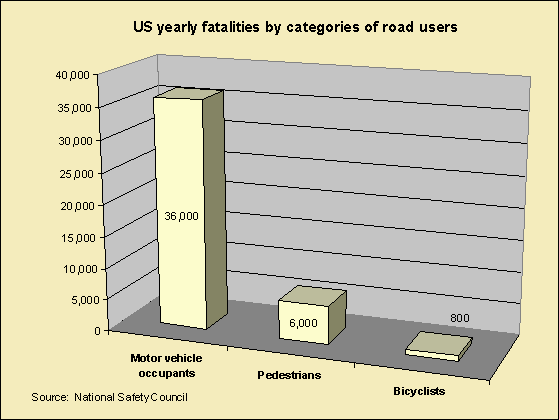
However, both bicycle and pedestrian fatalities and injuries disproportionally affect young people. In the 5 to 19 year old age group (roughly, from when young people are old enough to play without constant supervision to when they go out to make their own way in the world), bicyclist fatalities are about 400, pedestrian fatalities about 1600, and vehicle occupant fatalities about 2000, according to 1986 Centers for Disease Control figures. Traffic fatalities are the largest cause of death in this age group. In terms of years of life lost or -- as is far more common -- impaired by disabling injury, the effect on the lives of children is greater than on older people. Violence, AIDS, drownings, cancers and other diseases -- none of these impacts our children as much as traffic, though many of these problems get far more attention. |
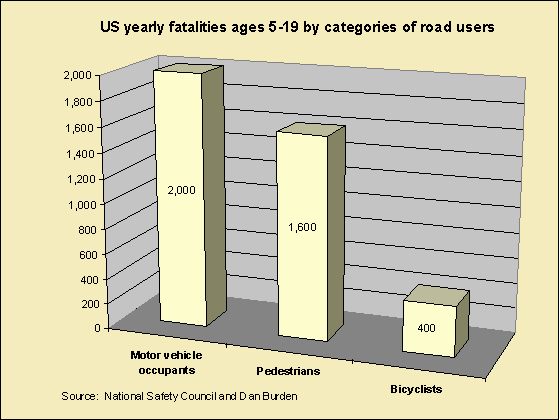
But still, bicyclist fatalities are only 10 percent of child traffic fatalities. Shouldn't we then address pedestrian and vehicle occupant hazards and ignore bicycling? I don't think so. We don't dismiss water safety training because only some children swim: we provide this training to the children who do go swim. Bicycling skills education and helmet use are very important to reduce risks for those children who do ride. Responsible bicyclists' organizations support education and helmet use. As bicyclists, we care about bicycling, and we want it to be safe and enjoyable for those who participate in it. We want more people to feel that bicycling is reasonably safe for them and their children, so they will want to ride bicycles too. In fact, with proper training and helmet use, bicycling is reasonably safe. Without them, it is far less safe. But what do these concerns matter to the larger society? Most people don't ride bicycles themselves even if they care about "bicycle safety," and some people even suggest restricting or eliminating bicycling in order to reduce exposure to its hazards. As the argument goes, "bicycles are too dangerous, so we don't want to encourage them." That's a direct quote, by the way, from former Massachusetts Secretary of Transportation Fred Salvucci, and typical of attitudes of many in the transportation establishment -- as if bicycles, rather than motor vehicles and their drivers, are the major traffic safety problem. Thoughtful bicyclists don't accept this approach, and neither should the society at large. Aside from the undeniable environmental advantages and the pleasure of bicycling, it is an important means of transportation to children who can not yet drive, and to adults who seek to save money or get healthy exercise as part of their daily routine. Bicycling also can in some cases be faster and more convenient than motoring: -- why else would urban couriers ride bicycles? Studies suggest that the years of life gained due to exercise from bicycling greatly outweigh the years of life lost due to bicycle accidents (an argument which has most cogently been put forward by the British Medical Association). When I ride my bicycle, I reduce my risk of early death or disability from a heart attack or stroke more than I increase it by the risk of a crash. Bicycling can also save time on a day-to-day basis, because it is transportation and exercise at the same time, and it saves money, and as the saying goes, time is money. If we accept that we should encourage or even just tolerate bicycling, then it is our responsibility to educate our children to do it properly. And this point leads to the core of my message: The most responsible and effective education program to reduce traffic fatalities, the largest killer of children, is a comprehensive education program which targets walking, bicycling and motoring in a coordinated way. Education for pedestrian skills, bicycling and motoring needs to occur at the ages at which children take them up and become exposed to their risks. Each step of education can build on the previous one. At age five, when children begin to walk in their neighborhoods unaccompanied by adults, they begin to learn scanning and searching, and other techniques for crossing streets. This element of the program establishes the basis for additional traffic education. At age nine or ten, when children begin to have permission to ride their bicycles around their neighborhoods, they learn the traffic law and the skills they need to operate a bicycle efficiently and safely. And at age fifteen, children get the traditional driver training to learn to operate a motor vehicle. This is far easier to teach because of what they already know. This is the standard sequence of instruction in European countries. In Holland, every child must take the traffic exam to be promoted from second to third grade. In France too, all children learn le code de la route in second grade. And guess what -- European children, large numbers of whom ride bicycles, obey the traffic law. And so do the teenagers on mopeds and the adults, whether driving cars or riding bicycles. |
Loches, France, summer, 1989:
a boy, age about 15, on a moped
waiting to make a vehicular left turn
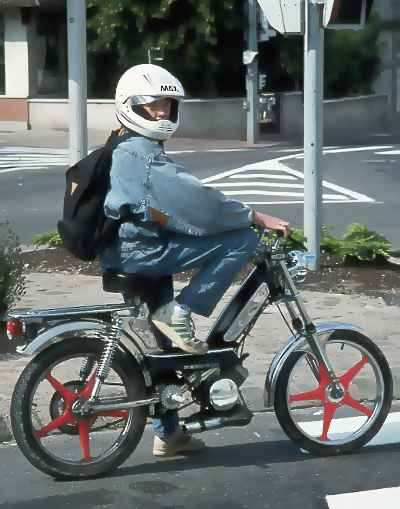
In the United States, unlike in Europe, we subscribe to the illusion that traffic education is only about learning to drive a car. We delay the teaching of traffic law and vehicular operation to age 15 or 16. This leads to two very serious problems:
|
Hyannis, Massachusetts, 1986
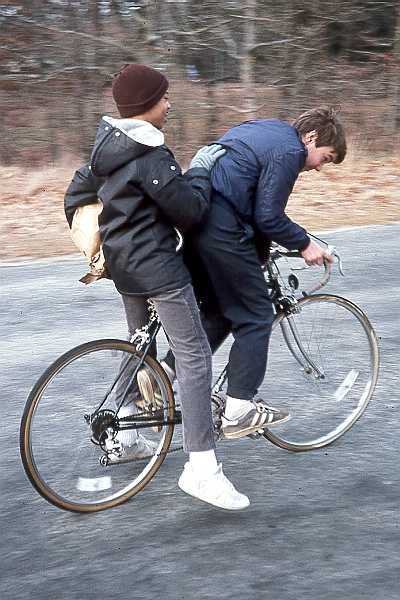
By failing to teach our children at an early age, we give them the ten years between the ages of five and fifteen to develop bad habits which a few weeks of driver training at age 15 can not overturn, and which many carry with them for the rest of their lives. These bad attitudes apply between motorists, and they apply to the way motorists treat bicyclists and pedestrians. It is hard to regard bicyclists and pedestrians as equally important and legitimate participants in traffic if you have yourself never been taught any self-respecting or legitimate way to be a bicyclist or pedestrian. |
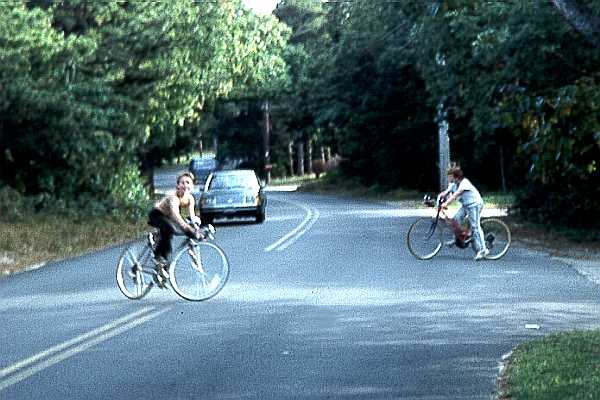
It is of perhaps even greater importance to notice that traffic is the major sphere of activity in which citizens interact daily with large numbers of other citizens who are not their family members, personal acquaintances or colleagues. Attitudes of cooperation and civic responsibility, learned at an early age, carry forward through life and are passed down to the next generation by example as well as by instruction. Can we afford the program?The argument is frequently put forward that our schools are overburdened with other special curricula: AIDS education, violence reduction and the like, and there is not enough time for traffic education.. But this argument has not one but several answers:
Comprehensive programs in traffic safety education have been demonstrated significantly to reduce the numbers of deaths and disabilities to children due to traffic. Reduced burdens on our health care and emergency system make the program a net benefit. Reducing deaths and injuries is of incalculable value. Let's do it. I would like to give credit to former Florida Department of Transportation Bicycle Coordinator, Dan Burden, for some of the insights expressed in this article.. |
| Top: John S. Allen's Home
Page Up: Bicycle Programs Contact John S. Allen by e-mail |
Contents , © 2002, John S. Allen |